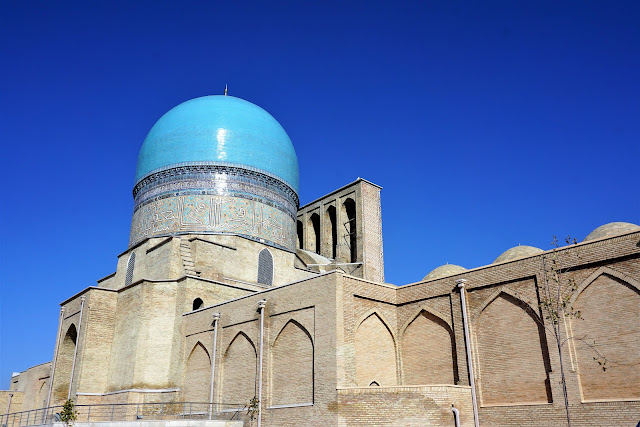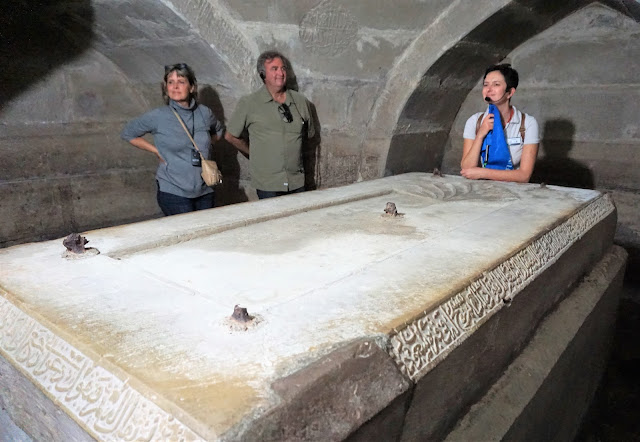 Scheherazade, sometimes called Shahrazad, is the fictional wife of an Arabian sultan and the storyteller in One Thousand and One Nights, the book that contains the tales of Aladdin, Ali Baba, Sinbad, and others. What does that have to do Uzbekistan? Nothing, I think, except for the fact that the name of an Uzbek city we visited, Shahrisabz, sounds so much like Scheherazade/Shahrazad. Scheherazade also looks like she belongs in Uzbekistan. (At least she does in this 19th century painting by Sophie Anderson.) I guess that's just my untrained ear. What do I know about Arabic? Nothing.
Scheherazade, sometimes called Shahrazad, is the fictional wife of an Arabian sultan and the storyteller in One Thousand and One Nights, the book that contains the tales of Aladdin, Ali Baba, Sinbad, and others. What does that have to do Uzbekistan? Nothing, I think, except for the fact that the name of an Uzbek city we visited, Shahrisabz, sounds so much like Scheherazade/Shahrazad. Scheherazade also looks like she belongs in Uzbekistan. (At least she does in this 19th century painting by Sophie Anderson.) I guess that's just my untrained ear. What do I know about Arabic? Nothing.
Also, Shahrisabz (the city in Uzbekistan) has a mysterious aura, a sense of having walked into an enchanted land from a distant time. Indeed, the city was founded over 2,700 years ago, was conquered by Alexander the Great over 2,300 years ago, and was the place where Alexander met his wife Roxanna. It was the birthplace of Timur in 1336 and the site of much intrigue in the following years. I wouldn't be surprised at all to see a flying carpet or a genii floating overhead.
Okay, maybe I would, but it's a pretty magical place all the same.
We started at the Kok Gumbaz Mosque, built by Ulugbek (the grandson of Timur and a much nicer guy than his grandfather) in 1435 to honor his father. The unimaginative translation of "Kok Gumbaz" is "blue dome."
That's not paint on the dome--it is azure tiles. It looks like and airy, but the engineering that supports such heavy covering must be pretty complex. A light stripe containing excerpts from the Quran surahs runs around the base of the dome.View from the back. Do you see the large vertical piece in front of the dome on the other side?
That is the wall that frames the main entrance . . .
. . . and the dome disappears behind that wall as visitors approach:
I never get tired of the complex patterns on the tiles:
An ablution station in the courtyard mimics the architecture of the main dome:
Those 15th century architects and engineers had the pointed arch mastered. It is everywhere:
The interior of the mosque is square, and with a diameter of over 150 feet, the interior portion of the dome is immense. Did I mention yet how impressive the engineering is?
The mihrab and minbar:
Intricate patterns and script above the mihrab and minbar:
A turquoise tile base encircles the room, highlighting the more subdued walls, which remind me of a quilt, every square being a different pattern:
The left and right sides of the window opening above:
Just across a small courtyard from the mosque is the double-domed Dorut Tilavat Mausoleum:

I like this sign:
Timur's and an important religious figure of the time, Shamsiddin Kulol, who was Timur's teacher, are buried here. I am not sure whose tomb is whose:
Even the interior of the dome is quite similar:
This tomb gets its own room. I'm guessing that it belongs to Timur's teacher:
I'm sure that's what our friends were doing:
One more key building that's part of this complex is the Jahongir and Omar Sheikh Mausoleum where Timur was supposed to be buried but wasn't. As noted earlier, he ended up in Samarkand. He had this building constructed after his eldest son, Jahongir, died an untimely death in 1376. When Timur's second son, Omar Sheikh, was killed in battle in about 1394, he was also interred at this mausoleum.
This building hasn't been as fully restored as the other buildings on site.
A few scrawny patches of tile still cling to the walls:
It was nice to have some English on the sign:
A tomb for Timur was built underground and is accessed by this door and some steep stairs:
A sign above the door identifies Timur (Temur) as the person for whom the tomb was built:
Timur was born in 1336 and died in 1405, so I'm not sure what the dates refer to--maybe the time he lived in Shahrisabz?
It's a pretty big sarcophagus--especially for an empty one.
That wrapped up our tour of this mosque and mausoleum compound, so we were released by our guides to prey upon the shopkeepers. Many in our group consistently found shopping to be the best part of any day:
Money doesn't grow on trees in Shahrisabz, but bags do, and several were exchanged for money while we were there.
Bob and I ended up finding a quiet place to sit and think about the day's activities. There was so much to process! We saw some rare graffiti on one of the intricately carved posts. There just isn't much graffiti in The Stans. It looks like things didn't turn out well for whoever did this one :
The view between the gazebo posts was pretty spectacular. (Note the two ladies in the bottom right corner carrying their bags of souvenirs.)
There were quite a few of these gazebos sprinkled around the grounds, quiet places for meditation . . .

. . . or for some (not us), a place to spread out their purchases to see if they needed to go back for more.










































A very beautiful place with nice grounds. I'm glad you are recording this as my memory is fading on the distinction of some of these places in Uzbekistan. After awhile, many of these places start to look alike (much like many of our western churches look alike).
ReplyDeleteI looked up Wudu, the ablution rites, and it's pretty complex. They now sell wudu basins online, so you could install one at your home, I suppose. Beautiful mosque. I'm afraid I would have been one of those shopping--anything textilish calls to me.
ReplyDeleteMimi , June 13, 2019 , 4:08 PM
ReplyDeleteThank you for posting those beautiful pictures of your visit to Shahrisabz. It helped me to decide to visit or no once I get in Samarkand, UZ. Its architecture/style is no doubt about it either made or inspired by Persian Master Architectures of 14oo's, 1500's and 1600's...very alike to what you see in today Iran. I do appreciate posting it.